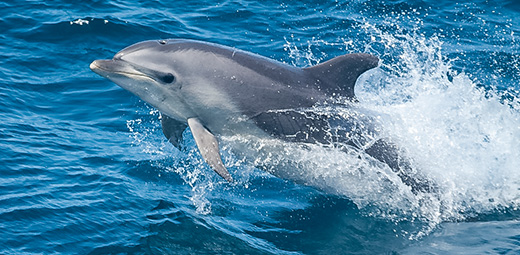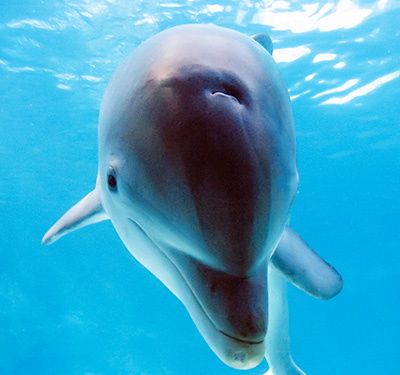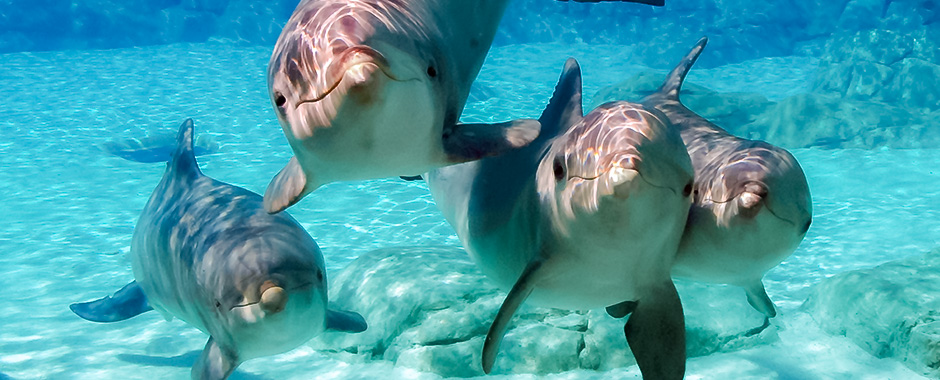Swimming
Swimming speed and duration are closely tied: high-speed swimming probably lasts only seconds, while low-speed swimming may last for long periods of time.
Bottlenose dolphins routinely swim at speeds of 4.6 to 10.2 feet per second (3.14 to 6.95 miles/hour; 5.04 to 11.19 km/hour) with a mean speed of 4.9 to 5.6 f/s (3.34 to 3.82 miles/hour; 5.4 to 6.14 km/hour).
- Maximum observed speed of a trained bottlenose dolphin swimming alongside a boat was 26.7 feet/second (18.20 miles/hour; 29.30 km/hour).
- Maximum observed swimming speed of a dolphin swimming upward prior to a vertical leap was 36.8 f/s (25.09 miles/hour; 40.38 km/hour). Both were completed in very short durations.
- Maximum swim speed that could be observed for wild dolphins was 18.3 f/s (12.47 miles/hour; 20.08 km/hour).
Dolphins are among the world's most efficient swimmers.
- A dolphin's characteristic fusiform shape is quite energy-efficient for swimming.
- Compared to other body shapes, this shape creates less drag (the opposing force an object generates as it travels through water). Blubber smoothes the contour of a dolphin and contributes to its smooth shape.
Bottlenose dolphins sometimes "porpoise" at the surface; they swim fast enough to break free of the water, flying up and out and then back under in one continuous movement, which they generally repeat. Porpoising uses less energy than swimming fast at the surface.
Certain toothed whales, such as bottlenose dolphins, sometimes ride ocean swells or a boat's bow or stern wake. Riding a wave or a wake, a dolphin can go almost twice as fast using the same energy cost.


Respiration
A dolphin breathes through a single blowhole on the top surface of its head. The blowhole is covered by a muscular flap, which provides a watertight seal.
- A dolphin holds its breath while below water.
- The dolphin opens its blowhole and begins to exhale just before reaching the surface of the water. To open the blowhole, the dolphin contracts the muscular flap.
- At the surface, the dolphin quickly inhales and relaxes the muscular flap to close the blowhole.
During each respiration a dolphin exchanges 80% or more of its lung air. This is much more efficient than humans, who exchange only about 17% of their lung air with each breath.
Exhaling and inhaling takes about 0.3 seconds. A bottlenose dolphin's respiratory rate is about 1.5 to 4 respirations per minute.
The visible spout of water that often rises from a dolphin's blowhole is not coming from the lungs, which (like ours) do not tolerate water.
- Water that is on top of the blowhole when the powerful exhale begins is forced up with the exhaled respiratory gases.
- Especially in cool air, a mist may form; it is water vapor condensing as the respiratory gases expand in the open air.


Diving
Bottlenose dolphins generally do not need to dive very deep to catch food.
- Depending on habitat, most bottlenose dolphins regularly dive to depths of 3 to 46 m (10 to 150 ft.). The average dive duration of coastal bottlenose dolphins ranges from 20 to 40 seconds. Mean dive duration of 25.8 seconds.
- They are capable of diving to greater depths. Under experimental conditions, one bottlenose dolphin dove to 390 m (1,280 ft.). In another study, a female, offshore bottlenose dolphin dove to depths of 492+ m (1,614 ft.).
On average a dive may last up to 10 minutes. A bottlenose dolphin's maximum breath-holding capability is about 12 minutes.
- The maximum voluntary breath-hold recorded for a coastal bottlenose dolphin was 7 minutes 15 seconds The maximum breath-hold duration registered for a tagged off-shore bottlenose dolphin was 14 minutes.
All marine mammals have special physiological adaptations for diving. These adaptations enable a dolphin to conserve oxygen.
- Dolphins, like other marine mammals, have a slower heart rate while diving. During a dive, blood is shunted away from tissues tolerant of low oxygen levels toward the heart and brain, which require a constant supply of oxygen.
- Certain protein molecules — hemoglobin and myoglobin — store oxygen in body tissues.
- Hemoglobin occurs in red blood cells. Long-diving mammals have higher blood volumes (as a percent of body weight) than do shallower-diving mammals.
- Myoglobin occurs in muscle tissue. The muscle of whales has a higher myoglobin concentration than the muscle of land mammals.
Both humans and cetaceans can experience negative physiological impacts from diving.
- As pressure increases with depth, the amount of gas that goes into solution in a diver's blood and body tissues also increases. At about 2 atmospheres of pressure (about 18 m or 60 ft.), tissues are saturated. If a human diver returns to the surface too quickly, the gases, especially nitrogen, come out of solution and form bubbles in muscles and blood. This painful and sometimes fatal condition is called "the bends."
- The bends is most common in scuba divers, but human breath-hold divers can also get the bends from deep diving. Under pressure, a human's bronchioles collapse. Lung air is forced into the alveoli: the numerous tiny areas of the lungs where gas exchange takes place. Here, gases are absorbed under pressure.
- Unlike human scuba divers, a dolphin doesn't breathe air under pressure. It inhales only at the surface. Furthermore, in diving mammals, the alveoli collapse at about 3 atmospheres of pressure (about;27 m, or 90 ft.), forcing air into the bronchioles (rigid air passages), a region where gases are not exchanged.

Thermoregulation
Like other mammals, dolphins maintain a constant body temperature. A dolphin's core body temperature is about 36° to 37°C (96.8° to 98.6°F), about the same as that of a human.
Dolphins have several thermoregulatory strategies to retain or release heat.
- Decreased surface-to-volume ratio.
- The dolphin's fusiform body shape and reduced limb size decrease the amount of surface area exposed to the external environment. This helps dolphins conserve body heat. Dolphins adapted to cooler, deeper water generally have larger bodies and smaller flippers than coastal dolphins, further reducing the ratio of surface area to overall body mass.
- Increased insulation.
- Dolphins deposit most of their body fat into a thick layer of blubber. This blubber layer insulates the dolphin, helping to conserve body heat. Blubber differs from fat in that it contains a fibrous network of connective tissue in addition to fat cells. A bottlenose dolphin's body fat generally accounts for about 18% to 20% of its body weight.
- Heat exchange system. A bottlenose dolphin’s circulatory system adjusts to conserve or dissipate body heat and maintain body temperature.
- Arteries in the flippers, flukes, and dorsal fin are surrounded by veins. Thus, some heat from the blood traveling through the arteries is transferred to the venous blood rather than the environment. This countercurrent heat exchange aids dolphins in conserving body heat.
- In cold water, circulation may decrease to blood vessels near the surface of the flippers, flukes, and dorsal fin, and increase to blood vessels circulating blood to the body core, thus conserving body heat.
- During prolonged exercise or in warm water, a dolphin may need to shed excess heat. In this case, circulation increases to blood vessels near the surface of the flippers, flukes, and dorsal fin, and decreases to blood vessels circulating blood to the body core. Excess heat is shed to the external environment

In general, bottlenose dolphins have a higher metabolic rate than land mammals of similar size. This increased metabolism generates a great deal of body heat.
Mammals lose body heat when they exhale. But dolphins conserve a considerable amount of heat because they breathe less frequently than land mammals.
Sleep
When studying sleep in bottlenose dolphins, researchers found that dolphins spent about 33% of each day sleeping.
Researchers have shown, through both observations and electro-physiological studies that deep sleep in bottlenose dolphins and other whales may occur in only one brain hemisphere at a time.




